South America: Exploring the land of the Jaguar
18.09.09 by Dan Ryan
No other big cat lives such a mythical existence as the Jaguar. So rarely seen in the wild it might then be surprising then that it is one of the few words in English of Guaraní origin. But the Jaguar’s future and that of the people that named it go hand in hand.
The Guaraní are an often forgotten group of people but their plight made the news yesterday when a village in Brazil was torched leaving the 130 inhabitants homeless and living in tents by the side of the road.
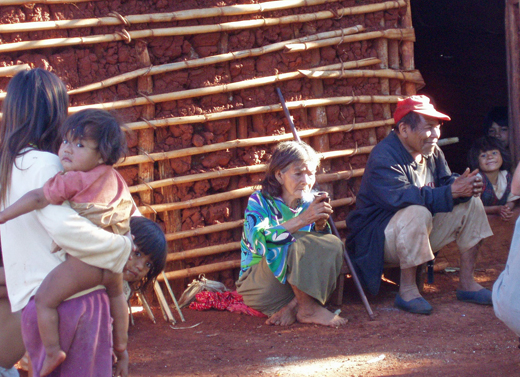
A Guaraní chief (Cassique) surrounded by his family.
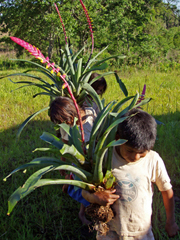 The truth is they should never be out of the news as theirs is a fight arguably more perilous than many indigenous peoples who garner far more international media attention. It goes without saying that the continued Guaraní social struggle is inextricably hand-cuffed to ongoing environmental degradation, but theirs is a modern history carved by exploitation.
The truth is they should never be out of the news as theirs is a fight arguably more perilous than many indigenous peoples who garner far more international media attention. It goes without saying that the continued Guaraní social struggle is inextricably hand-cuffed to ongoing environmental degradation, but theirs is a modern history carved by exploitation.
On my first visit to Misiones, Argentina and its provincial capital, Posadas, the town square was filled with encamped Guarani. We talked to a few of them gathered under canvas in the intense sun and their plea to the Governor inside his mansion was a simple “please protect our home; we have nowhere else to go.”
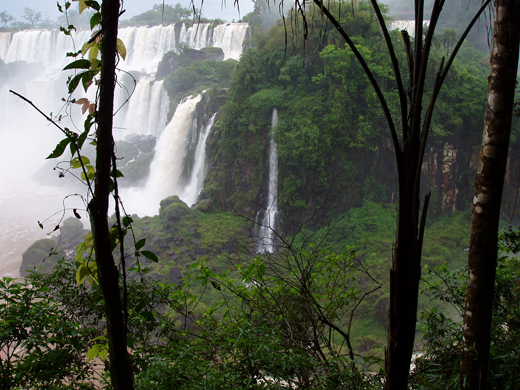
The waterfalls of Iguazu (Guaraní for Big Water)
erupt from the dense sub-tropical forests.
Their home is Atlantic Forest, or Mata Atlantica, and like the silent plight of its human inhabitants this is a landscape that has been over-looked by the international community. Ranking as one of the most threatened Biodiversity Hotspots, Atlantic Forest is home to an estimated 20,000 species of plants of which an incredible 8,000 are endemic. The trees carry with then an even more remarkable restriction, with 54 per cent only found in the narrow coastal strip that hugs the eastern seaboard of Brazil before arcing into northern Argentina and eastern Paraguay.
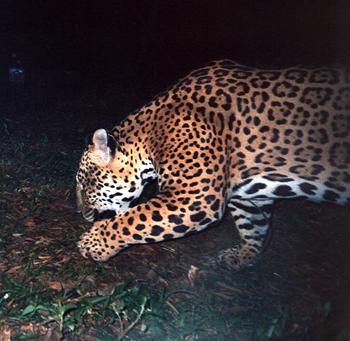 But the jaw-dropping diversity doesn’t stop at plants. Of the 263 mammals, 71 are endemic with 12 endemic genera. Of the 936 birds, 148 are endemic, with 22 endemic genera. Over 300 reptiles make their home in the forest, along with 483 recorded amphibians (with probably well over 50 per cent endemism), and at least 350 fish.
But the jaw-dropping diversity doesn’t stop at plants. Of the 263 mammals, 71 are endemic with 12 endemic genera. Of the 936 birds, 148 are endemic, with 22 endemic genera. Over 300 reptiles make their home in the forest, along with 483 recorded amphibians (with probably well over 50 per cent endemism), and at least 350 fish.
Large lone male Jaguar (Patudo) caught on a camera trap in Yaboti Biosphere Reserve, Misiones.
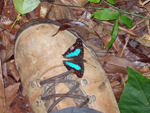 Much less is known about the invertebrates but one only need walk among the trees for a short while to be enveloped in clouds of butterflies to sense the extraordinary diversity of life in this forest.
Much less is known about the invertebrates but one only need walk among the trees for a short while to be enveloped in clouds of butterflies to sense the extraordinary diversity of life in this forest.
The Guaraní were one of the first indigenous people of South America to be encountered by European explorers and their naturally placid nature made them an easy target for persecution. Likewise the Atlantic Forest landscape was the first to be ransacked for the raw materials that would help build the new continent and feather the nest of the old (old habits die hard). To this day it remains the most populous area of Brazil as it contains the mega cities of Sao Paulo and Rio.
Estimates vary as to the fraction of Atlantic Forest remaining but it’s probably in the order of 7 – 10 per cent. Swathes of landscape have already been converted to barren pine plantations. Meanwhile the encroachment of soya, tobacco and cattle continues from all quarters. This forest insurgency means the buffer and corridor areas under protection are increasingly important as the quality of the extant fractions is somewhat depressing. There are very few contiguous chunks of forest cover left and the “Edge Effect” markedly impacts on the forestry by extrapolating the degradation process.
Deforestation and the conversion to agriculture has decimated
about 90% of the forest resource / D. Ryan
It is true that some Atlantic Forest in under some kind of protection, but it’s arguably not enough. The thinking needs to be bigger to protect this truly frontline habitat from further damage. It’s important we look to restorative techniques to bring back connectivity and bulk to the forest mass because it is in these unbroken chunks that the Guaraní, the plants, and the animals can thrive.
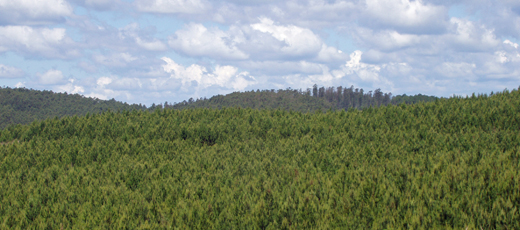
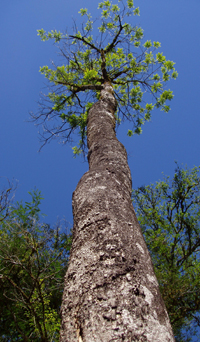 A sea of pine trees take the place of native forest / D. Ryan
A sea of pine trees take the place of native forest / D. Ryan
Much of what we know about the plants of Atlantic Forest we learnt from the Guaraní. Their rich lives have been entwined with the forest for thousands of years. Some of this ethnobotanical knowledge has been consumed into modern culture, particularly the Yerba mate infusions of Ilex paraguariensis (pictured right) that are so common. Some of it is being studied while I write and some of it presumably will always remain a secret. It is this threat of cultural extinction and the knowledge that goes with it that adds weight to traditional conservation measures: it is not just plants and animals that lose their right to life.
In the UK we treasure the remains of our long-gone woodland. We delight in a couple of hectares here and there of forest cover. But this paucity of forest means we have been left with nothing but scant remnants of our native flora and fauna. We don’t remember our woodland of old, but we do remember the Atlantic Forest. We must not be the custodians of its demise.
Ways you can help...
Survival International
World Land Trust - US